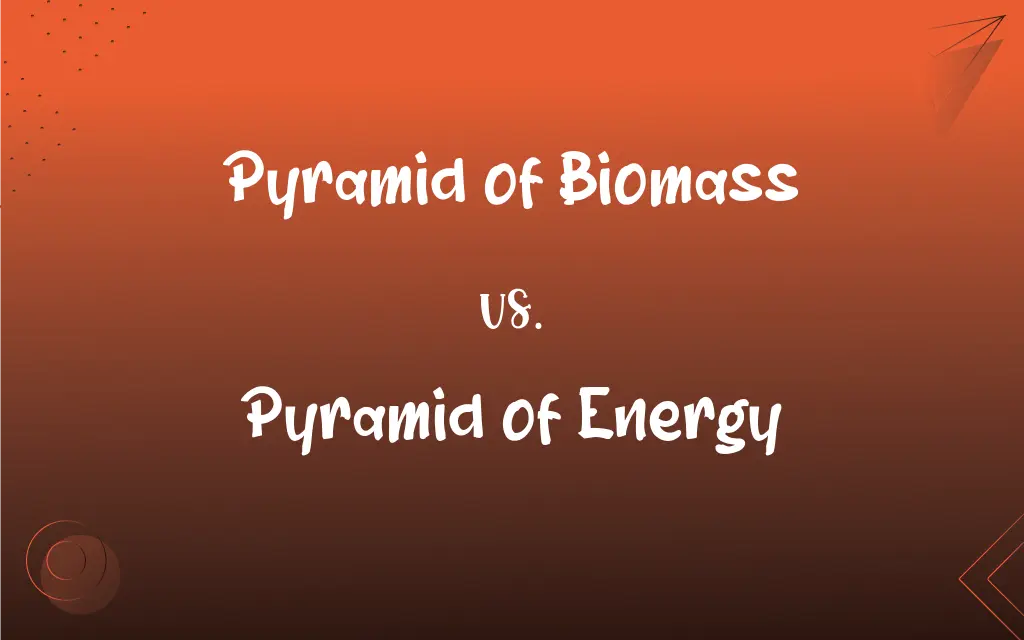Pyramid of Biomass vs. Pyramid of Energy: What's the Difference?
Edited by Aimie Carlson || By Harlon Moss || Published on February 2, 2024
A pyramid of biomass illustrates the total mass of organisms at each trophic level, while a pyramid of energy shows the flow of energy through trophic levels, decreasing at each stage.

Key Differences
The pyramid of biomass is a graphical representation showing the total mass of living material at each trophic level in an ecosystem. It quantifies the biomass present in each level, typically decreasing from producers to apex predators. Conversely, the pyramid of energy represents the flow of energy from one trophic level to the next, illustrating how energy decreases as it moves through the ecosystem, following the second law of thermodynamics.
In the pyramid of biomass, the units are in terms of mass per unit area (such as grams per square meter). This pyramid can be inverted in certain ecosystems, like aquatic ones, where the biomass of producers (phytoplankton) is less than that of consumers. The pyramid of energy, measured in energy units per area per time (such as kilocalories per square meter per year), always shows a right-side-up pyramid because energy consistently diminishes at higher trophic levels due to energy loss as heat.
Pyramid of biomass is influenced by the lifespan and reproduction rate of organisms. Short-lived producers like phytoplankton may have less total biomass at a given time than longer-lived consumers. The pyramid of energy, however, is unaffected by these factors, focusing solely on the energy transfer efficiency between trophic levels, typically around 10% from one level to the next.
Another aspect of the pyramid of biomass is that it can vary seasonally and does not always reflect the dynamic nature of energy flow in an ecosystem. The pyramid of energy, in contrast, provides a more stable and consistent representation of energy transfer over time, highlighting the inefficiency of energy transfer in ecosystems.
Both the pyramid of biomass and the pyramid of energy are crucial for understanding ecological relationships and energy dynamics in ecosystems. While the biomass pyramid provides a snapshot of the physical presence of organisms, the energy pyramid offers insight into the functional and energetic dynamics of the ecosystem.
ADVERTISEMENT
Comparison Chart
Representation
Mass of organisms at each level
Energy flow through each level
Units
Mass per unit area
Energy per area per time
Shape Variation
Can be inverted (e.g., in aquatic ecosystems)
Always right-side-up
Influenced By
Organism lifespan, reproduction
Energy transfer efficiency
Reflects
Physical presence of organisms
Functional energy dynamics
ADVERTISEMENT
Pyramid of Biomass and Pyramid of Energy Definitions
Pyramid of Biomass
A chart illustrating the mass of producers, consumers, and decomposers in an ecosystem.
An aquatic pyramid of biomass often has a smaller base due to the lower mass of phytoplankton.
Pyramid of Energy
A diagram showing how much energy is passed on from one trophic level to the next.
In a coral reef, the pyramid of energy illustrates the diminishing energy available to reef fish and predators.
Pyramid of Biomass
A representation of the quantity of living material at each level in a food web.
The pyramid of biomass in a tropical rainforest is heavily weighted towards the producers.
Pyramid of Energy
A representation of energy quantity at each level of the food web.
The pyramid of energy in a grassland ecosystem shows a rapid decrease in energy available at higher levels.
Pyramid of Biomass
A diagram showing the biomass present at each level of the food chain.
In a grassland ecosystem, the pyramid of biomass is dominated by grasses at the base.
Pyramid of Energy
A diagram that illustrates the transfer of energy through the food chain.
An agricultural pyramid of energy demonstrates how much energy is lost from crops to herbivores.
Pyramid of Biomass
A diagram quantifying the biomass at each trophic level in an ecological community.
A desert ecosystem's pyramid of biomass shows a large proportion of producers like cacti.
Pyramid of Energy
A graphical representation of the flow of energy at each trophic level in an ecosystem.
The pyramid of energy in a marine ecosystem shows a large energy loss between trophic levels.
Pyramid of Biomass
A graphical representation of the total mass of organisms at each trophic level in an ecosystem.
The pyramid of biomass in a forest ecosystem shows a large base of trees and shrubs.
Pyramid of Energy
A chart depicting energy transfer efficiency from producers to apex predators.
The pyramid of energy in a forest ecosystem highlights the low efficiency of energy transfer to carnivores.
FAQs
What is a pyramid of energy?
A graphical representation of the energy flow through different trophic levels in an ecosystem.
What are the units for a pyramid of biomass?
It is usually measured in mass per unit area, like grams per square meter.
What is a pyramid of biomass?
A diagram showing the total mass of living organisms at each trophic level in an ecosystem.
What are the units for a pyramid of energy?
Typically, it's measured in energy units per area per time, like kilocalories per square meter per year.
What does a pyramid of biomass represent?
It represents the physical mass of producers, consumers, and decomposers in an ecosystem.
What does a pyramid of energy illustrate?
It illustrates the transfer and loss of energy from one trophic level to another.
Can the pyramid of biomass change seasonally?
Yes, it can change with seasons due to variations in organism growth and reproduction.
Can the pyramid of biomass be inverted?
Yes, especially in aquatic ecosystems where producers like phytoplankton have less biomass.
Does the pyramid of energy vary seasonally?
It's more stable and less influenced by seasonal changes than the biomass pyramid.
What does the pyramid of energy tell us about an ecosystem?
It reveals the energy efficiency and health of an ecosystem.
Do all ecosystems have the same shape of biomass pyramid?
No, the shape can vary greatly between different ecosystems.
How do trophic levels appear in these pyramids?
They are depicted as different layers or steps in the pyramid.
What role do decomposers play in these pyramids?
Decomposers are crucial in recycling nutrients and energy, affecting both pyramid types.
How does the pyramid of biomass differ from the pyramid of energy?
The biomass pyramid shows the mass of organisms, while the energy pyramid shows energy flow.
Why is the pyramid of energy considered more accurate?
It consistently represents the energy transfer inefficiency in all ecosystems.
Are human activities reflected in these pyramids?
Yes, human activities can significantly alter both biomass and energy pyramids.
Why is the pyramid of energy always upright?
Because energy consistently diminishes at higher trophic levels due to inefficiencies in transfer.
How does the pyramid of biomass help ecologists?
It helps in understanding the physical structure and distribution of organisms in ecosystems.
Can these pyramids be used to assess ecosystem health?
Yes, they are crucial indicators of the balance and functionality of ecosystems.
Is the pyramid of energy uniform across ecosystems?
While its upright shape is consistent, the actual energy values vary between ecosystems.
About Author
Written by
Harlon MossHarlon is a seasoned quality moderator and accomplished content writer for Difference Wiki. An alumnus of the prestigious University of California, he earned his degree in Computer Science. Leveraging his academic background, Harlon brings a meticulous and informed perspective to his work, ensuring content accuracy and excellence.
Edited by
Aimie CarlsonAimie Carlson, holding a master's degree in English literature, is a fervent English language enthusiast. She lends her writing talents to Difference Wiki, a prominent website that specializes in comparisons, offering readers insightful analyses that both captivate and inform.































































